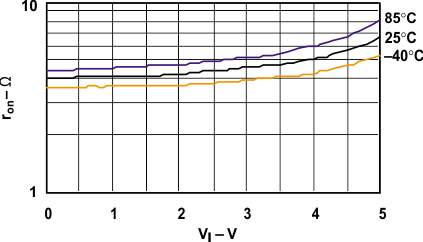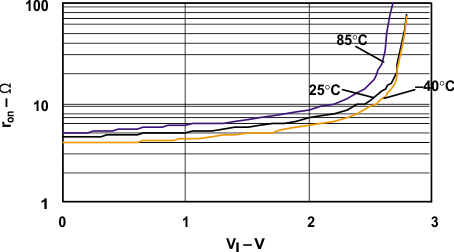SCDA008C June 2021 – November 2021 CD4052B , TS3A225E , TS3A44159
- Trademarks
- 1Introduction
- 2Semiconductor Switches
- 3Basic Signal-Switch Structures
- 4Key Concerns in Digital-Switch Applications
- 5Signal Switch Families
- 6Applications
- 7Conclusion
- 8References
- 9Revision History
-
A Test
Measurement Circuits
- A.1 Measurement Setup for ron
- A.2 Measurement Setup for VO vs VI Characteristics
- A.3 Voltage-Time Waveform Measurement (Switch On)
- A.4 Voltage-Time Waveform Measurement (Switch Off)
- A.5 Output-Skew Measurement
- A.6 Simulation Setup for Undershoot Measurement
- A.7 Laboratory Setup for Attenuation Measurement
- A.8 Laboratory Setup for Off Isolation Measurement
- A.9 Laboratory Setup for Crosstalk Measurement
5.3.1.2 ron vs VI
The CB3Q3306A has low and flat ron characteristics. Figure 5-12 and Figure 5-13 show ron versus input voltage characteristics at different values of VCC and at different temperatures. The output current for ron versus VI characteristics is –15 mA, and this characteristic is dependent on output current. For VCC = 3.6 V, ron is fairly constant from the 0-V to 5-V input-voltage range. For VCC = 2.3 V, ron is flat over the range of 0 V to 2.5 V and increases rapidly above 2.5 V.
 Figure 5-12 ron vs VI for the CB3Q3306A at VCC = 3.6 V (IO = –15 mA)
Figure 5-12 ron vs VI for the CB3Q3306A at VCC = 3.6 V (IO = –15 mA) Figure 5-13 ron vs VI for the CB3Q3306A at VCC = 2.3 V (IO = –15 mA)
Figure 5-13 ron vs VI for the CB3Q3306A at VCC = 2.3 V (IO = –15 mA)